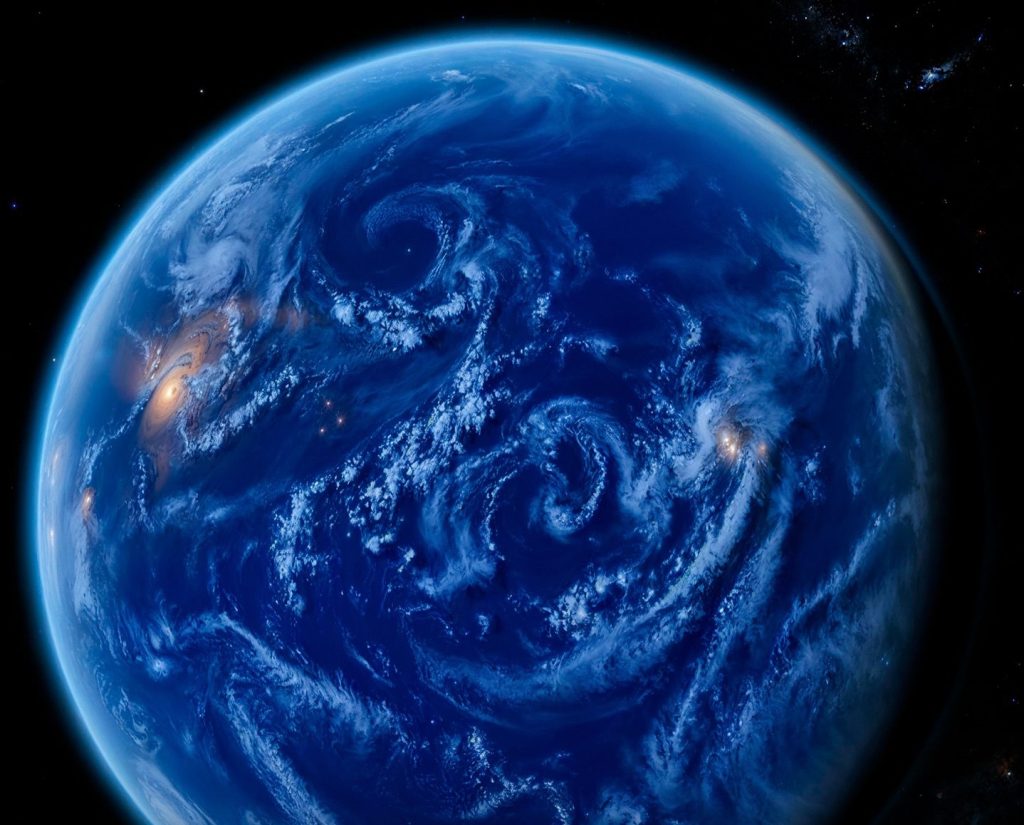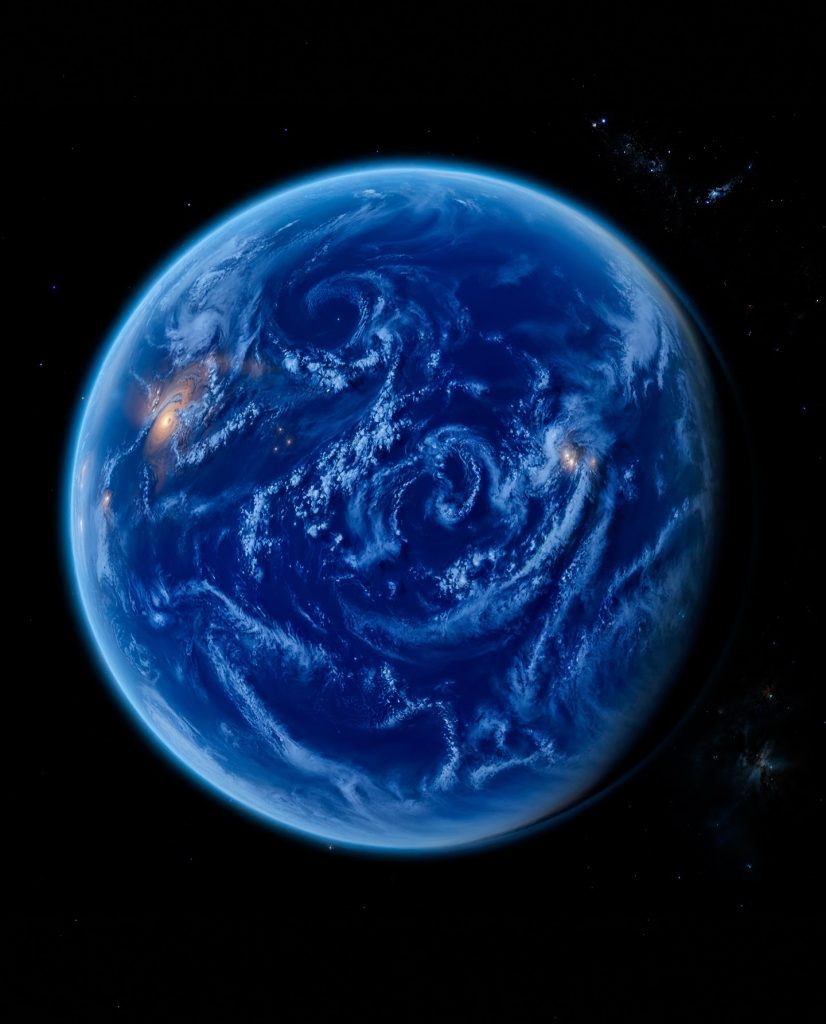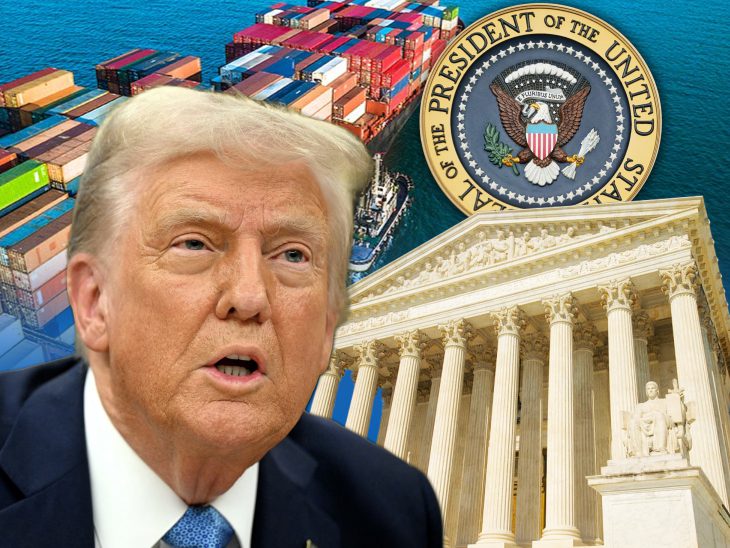The Side of Earth We Rarely Witness — A Planet Covered Almost Entirely by the Vast Pacific Ocean, Where the Continents Disappear Beneath Endless Blue
There’s a side of our planet that almost no one ever thinks about — the side where the continents vanish, where the familiar outlines of nations and cities are swallowed by endless blue. From this angle, Earth doesn’t look like the mosaic of borders and landmasses we know from maps and globes. Instead, it becomes something else entirely: a water world, dominated almost completely by one ocean so vast that it stretches across nearly a third of the planet’s surface. It’s the Pacific Ocean — Earth’s largest and deepest body of water, a colossal expanse that defines the true nature of our planet more than any continent ever could.

Seen from space, this view is humbling. No North America. No Europe. No Africa. Just the swirling blues of the Pacific, broken only by the faint outlines of tiny island chains scattered like freckles across a face of water. It’s a perspective that few humans ever get to see directly, captured by satellites orbiting thousands of miles above us. Astronauts who have glimpsed it describe it as otherworldly — a reminder that, despite our obsession with land and territory, Earth is, first and foremost, an ocean planet.
The Pacific covers about 165 million square kilometers — more than all the land on Earth combined. It stretches from the icy edges of the Arctic in the north to the frozen wilderness of Antarctica in the south, touching Asia, Australia, and the Americas along its rim. At its widest, it spans more than 19,000 kilometers. If you stood on the shore in Ecuador and looked west, the next time you’d hit land would be somewhere in Indonesia — after crossing an expanse so large it defies human imagination.
Even the name “Pacific” carries an irony born from history. When the Portuguese explorer Ferdinand Magellan crossed it in the early 16th century, he named it Mar Pacífico — the “peaceful sea” — after experiencing relatively calm conditions compared to the storms of the Atlantic. But that name belies the ocean’s true nature. Beneath its tranquil surface lies some of the most powerful forces on the planet: raging currents, immense tectonic trenches, and storms so fierce they can reshape coastlines. The Pacific is both serene and savage — a paradox that has shaped the evolution of life, the movement of continents, and the rise and fall of civilizations.
Its depths are equally staggering. The Mariana Trench, located near Guam, plunges nearly 11 kilometers below sea level — deeper than Mount Everest is tall. Down there, in total darkness, pressures exceed 1,000 times what humans experience at the surface. And yet, even in this hostile environment, life thrives. Tiny shrimp-like creatures, ghostly fish, and microbial colonies survive in conditions once thought impossible. It’s a stark reminder that the ocean’s mysteries are far from fully explored. Despite centuries of study, we’ve mapped less than 25% of the Pacific seafloor in detail. Most of it remains unknown — a final frontier hiding secrets we’ve only begun to uncover.
The Pacific isn’t just vast in space — it’s vast in history. Long before Magellan ever saw it, the ocean was home to some of humanity’s greatest navigators. The Polynesians, using only the stars, ocean swells, and the flight patterns of birds, crossed distances of thousands of kilometers in open canoes. They discovered and settled islands scattered across an area larger than the entire continental United States, from Hawaii in the north to New Zealand in the south, to Easter Island in the far east. Their achievements in navigation and seafaring remain among the greatest feats in human exploration, centuries before modern tools existed.

From a planetary perspective, the Pacific also plays a vital role in maintaining the Earth’s climate. It acts as a massive heat sink, absorbing and redistributing energy from the Sun. Its currents — such as the North Pacific Gyre, the California Current, and the Kuroshio — drive weather patterns across the globe. The El Niño and La Niña phenomena, both born from subtle changes in Pacific surface temperatures, can alter rainfall, storm intensity, and even agricultural productivity across multiple continents. When the Pacific warms, crops fail in Africa, monsoons shift in Asia, and winters soften in North America. In many ways, what happens here determines the rhythm of life everywhere else.
And yet, despite its size and influence, the Pacific also bears the scars of human activity. It is home to the Great Pacific Garbage Patch — an enormous swirl of floating plastic debris twice the size of Texas, trapped by oceanic currents in the North Pacific Gyre. Invisible microplastics now outnumber plankton in some regions. Scientists have found these particles in fish, in seabirds, and even in the deepest parts of the Mariana Trench. The Pacific’s vastness once seemed infinite, immune to our actions, but now it reflects the consequences of a species that has underestimated its own impact.
Still, the ocean endures. It continues to sustain life on an extraordinary scale. The Pacific teems with biodiversity — from the coral reefs of the Philippines and Micronesia to the open-water migrations of whales, sharks, and sea turtles. It supports economies and cultures across dozens of nations, from Japan and Indonesia to Chile and Fiji. For billions of people, it is not just a body of water but a source of identity, livelihood, and connection.
When astronauts describe seeing the Pacific from orbit, they often speak of feeling a kind of quiet awe. From that vantage point, Earth looks less like a planet of continents and more like a blue marble — fragile, unified, and alive. The thin band of atmosphere that separates ocean from space glows faintly, a reminder of how delicate the balance of life really is. From that distance, human borders disappear. The conflicts, the noise, the artificial divisions we draw on maps — all of it fades away, leaving only the gentle curve of blue and white.
It’s humbling to realize that this ocean, which covers nearly one-third of our planet, remains mostly unseen by us. Not just because of its remote expanse, but because we rarely think about it. We live our lives surrounded by land — by cities, roads, and mountains — forgetting that most of Earth’s surface lies far beyond our view, in waters deeper than imagination. Even our maps, designed to center continents, distort the Pacific, stretching or splitting it at the edges. Only from space does its true magnitude reveal itself — a single, continuous body of water that wraps around the world like a living skin.
Geologically, the Pacific is also a dynamic engine of creation and destruction. Its seafloor is constantly shifting, shaped by the movement of tectonic plates. The Pacific Plate — the largest on Earth — drives much of the planet’s seismic and volcanic activity. Along its edges lies the “Ring of Fire,” a horseshoe-shaped zone where earthquakes and eruptions are frequent. From Japan to California to Chile, this boundary defines the lives of millions who live atop the restless edge of the ocean’s power. Every tremor, every volcanic plume, is a reminder that the Pacific is not just vast, but alive — a force of motion and renewal beneath the calm of its waves.
The story of the Pacific is, in many ways, the story of Earth itself. It is the cradle of storms, the birthplace of islands, the keeper of secrets. It has connected civilizations, shaped migrations, and tested the limits of exploration. And yet, as we stand on the shores of the 21st century, it also challenges us — to protect what remains, to understand what we still don’t, and to remember that this ocean is not separate from us but part of the same fragile ecosystem we all share.
Perhaps that’s why this unseen side of Earth feels so profound. When we look at the Pacific from orbit, we are reminded that our planet is not a collection of countries or economies, but a single, breathing entity suspended in the dark. The blue that dominates that image is not just water — it’s life itself, the foundation of everything that exists above and below it. The side of Earth we never see is, in truth, the side that defines who we are.
In that endless blue expanse, there are no borders, no divisions, no human footprints. Just the vast, timeless calm of an ocean that has existed for hundreds of millions of years — long before us, and likely long after. And for a brief moment, as we look upon it, we see Earth not as a world divided, but as it truly is: one planet, one ocean, one home.



